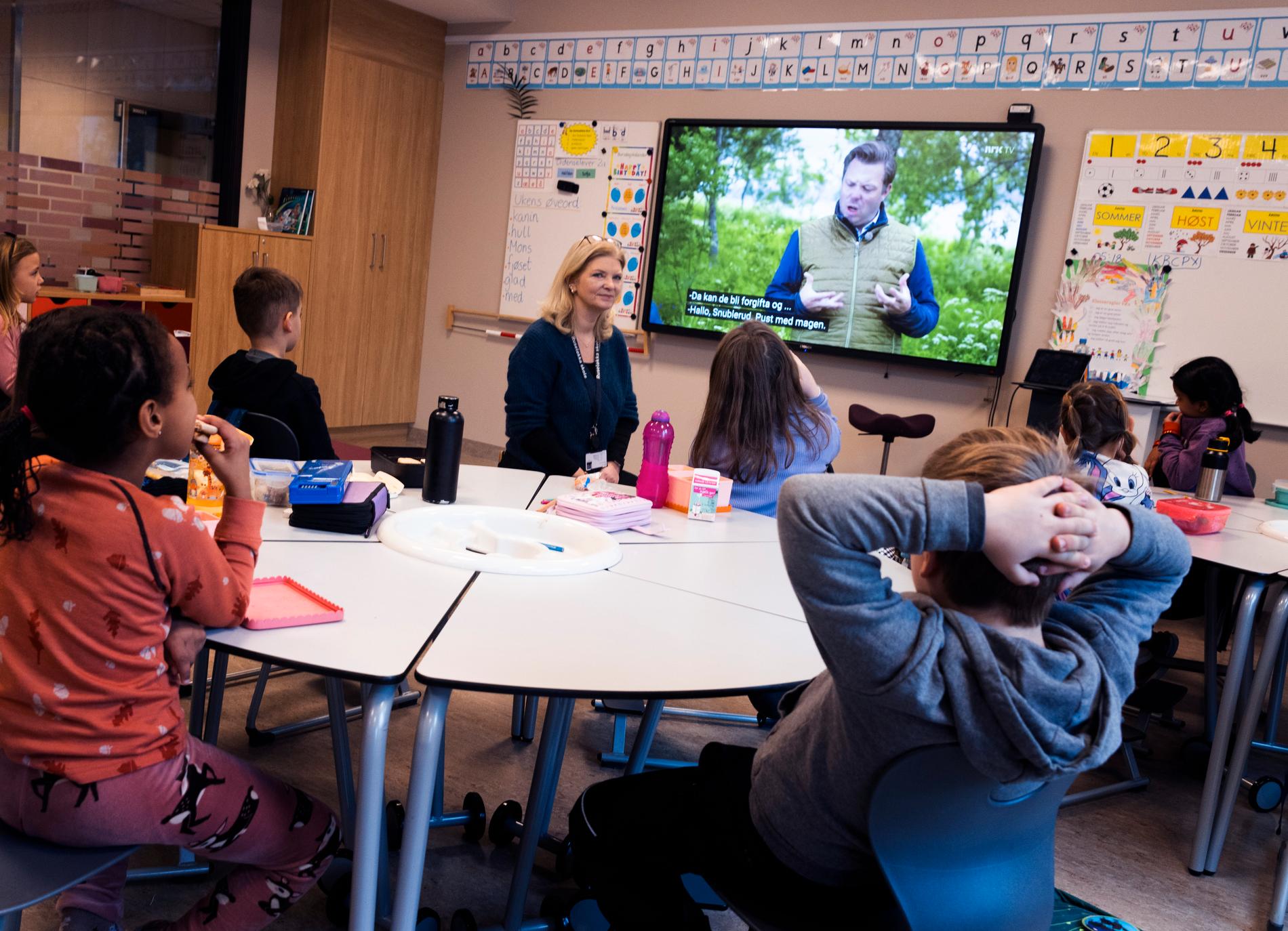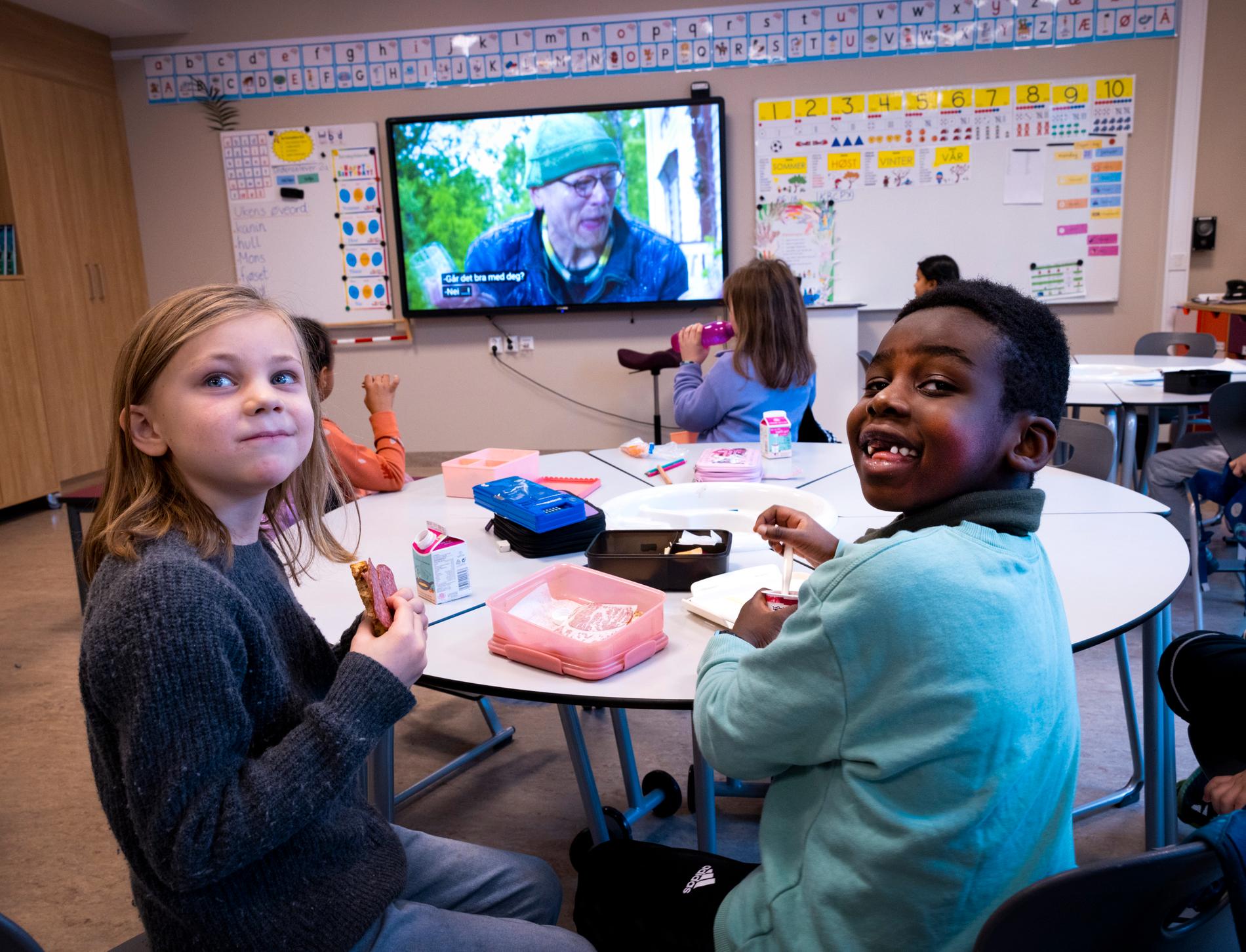RUSELØKKA SCHOOL (VG) The slice of bread with salami is chewed while the seven-year-old’s eyes absorb what is happening on the screen. Now a whole army of parents has risen up against screen use and TV viewing during the pupils’ lunch break.
Over half of Norwegian primary schools allow pupils to watch TV while they eat, shows a large survey in Aftenposten junior from 2020.
In social media, there has been a wave of pure protest by parents who want to make meal breaks at school a TV-free zone.
One of many mothers who have become involved, she writes that she is horrified by the television viewing during the children’s meal breaks. Several emphasize that the meal breaks should be for chatting and socializing rather than passively watching TV and more screen time.
– I think it is a complete crisis. So much crisis that when I found out about it, I put the coffee down my throat, says mum Maren Haugfos (39) from Drammen.
She has children at Bragernes school, and is one of many who want an end to schools allowing pupils to watch TV during meal breaks.

For Haugfos, it became a battle as soon as her child started school. She does not think that watching TV belongs in the pupils’ meal breaks. Then they should have time to talk with other children, listen to books being read, be social – and not least eat their food, says Haugfos.
She says that she knows of examples of school pupils coming home with large parts of their school meals uneaten.
Cathrine Ballo Olsen, mother of four, lives in Tromsø. She has children at Gyllenborg school. There, too, the pupils’ gaze alternates between the TV images on the large smartboard screen and the lunchbox.
– I reacted to it at the start, and was skeptical. But gradually I have become more positive when I have seen how this works, says Ballo Olsen to VG.
Her children’s school emphasizes variety between reading books and watching TV in the pupils’ lunch break.

Variety
They don’t show just anything on TV, according to the principal at the school, Jill Solheim-Olsen.
– This is break time that is not taken from the school’s and pupils’ hourly resources. What takes place during the lunch break is largely determined by pedagogues, specialist workers and assistants who supervise the pupils during this time. They control this. Sometimes it’s reading aloud, other times it’s watching TV, for example Super-Nytt on NRK, says the Tromsø rector.
– In addition, some children get their food more easily by sitting and watching TV – than if the eating has to take place at the same time as talking to fellow pupils, says mum Ballo Olsen.

During the lunch break for class 2-A at Ruseløkka school in Oslo, the noise level is not particularly high on a normal Monday in January.
Introductory talk during the break is soon drowned out by the voices of the two characters Tullerud and Snublerud in NRK Super’s Planet Patrol from the classroom’s own big screen – a Smartboard on the wall.
Today’s TV message: Don’t bury non-biodegradable rubbish.
Pupils Yosef Abed Al Munteleb Joseph (7) and Helle Paus Nerverud (7) show that they are able to take in both the lunch they brought for the day and the TV message.
– What do you think about watching TV while you eat?
Helle: – It is nice. Then we learn, for example, about the planet and other things that the TV programs are about.
Yoseph: – Better than not watching TV. I eat faster when I watch TV.
– Forgets to eat sometimes
– So you manage to eat while watching TV?
Helle: – Yes. But sometimes I forget to eat when I look at the screen, she replies.
Helle ate a carrot and two slices of bread with salami during her lunch break on Monday. But the favorite spread is something else, namely Nugatti.
Yoseph usually eats slices of bread with cheese.
– I eat everything together every single day, he reveals.
– What do you most like to watch on TV while eating?
– The Planet Patrol. Today it was about not burying the rubbish, Yoseph replies.

The principal of the pupils at Ruseløkka, Merete Hansen, emphasizes that the pupils do not watch TV during meal breaks every day.
– The most important thing to say is that we must not look at the half-hour lunch break in isolation. But that it is part of the school day as a whole, says Hansen.
She adds:
– It is not the case at Ruseløkka that students look exclusively at screens during all meal breaks. We have, for example, reading aloud, chatting with the side friend and question games during this time as well. We also have some classes where you don’t use a screen during the lunch break at all, and that’s perfectly fine.
Start discussions
In some meal breaks, they see screen use as an initiator of a small discussion – where you watch a few minutes of, for example, Super-News, and then start a conversation about the content.
– So should the students have time to eat?
– Yes, and therefore it is important that it does not become too chaotic, and that the adults have time to help and support. We know that if children are looking at a screen all the time, they can forget to eat. They may also forget to feel when the feeling of satiety is coming. That’s why we try not to look at screens during the entire lunch break, the headmaster replies,

